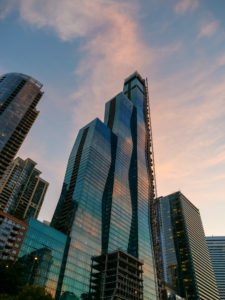
At 101 stories, the Saint Regis Tower in Chicago is the world’s tallest building by a woman architect, Jeanne Gang. Previous blogs have discussed the work of women architects—both contemporary and historic.
[O]ne of my professors told me one time, you know, Jeanne, you know, it’s great that you’re studying architecture, but, you know, do you think a man really wants to hire a woman to design buildings? But those kind of things just really got me super excited to, like, prove them wrong, you know what I mean?—Jeanne Gang
Making tall buildings livable for people…
Chicago’s famous winds can cause a tall building to sway noticeably, even to the point of causing motion sickness. Engineers use different techniques to damp the motion. Weights on the upper floors counter the effects of the building’s natural harmonics. Tanks of liquids are particularly effective for this purpose. The motion of the liquid—water in this case—is out of sync with that of the building itself.
The Saint Regis Tower also incorporates a less common technique: a “blow-through” floor. That is, the 83rd floor is open so the wind can blow through it. Reducing the wind load in this way allowed a reduction in building materials.
In addition, concrete cores and a shear wall resist lateral loads from wind.
A tall glass monolith can look forbidding and concentrate the wind at the street level. But several features keep Saint Regis Tower from being a monolith. The apparent curvature of the curtain wall is an optical illusion. The perimeter columns are straight, but the edge of each floor is offset from the neighboring floor by 5 inches. Six shades of the exterior blue-green glass grade to darkest on the smallest floors, offsetting the greater sun exposure there.
According to the architects, the glass, made in Germany, cuts down on heat gain and saves energy. It also has an aesthetic advantage, accentuating the thinness of each stem.—Blair Kamin, Chicago Tribune, 23 November 2020
At street level, an open passageway connects the park at Lakeshore East with Chicago’s Riverwalk to the north. Both are open to the public.
…And birds
Because the Midwest is so flat, it’s almost like Chicago is, like, a mountain range. It’s a phenomena. So you come out of your way to go see it. And so it did impress me a lot when I was growing up and coming from a small town. But I think the small town gave me the sense of community and also a connection to nature that I still try to keep present in the work.—Jeanne Gang
I don’t think it’s exclusive to women to be interested in the things that I’m interested in. It’s culture that assigns those divisions, (like) nature equals woman. My work is my work. It’s physics and structure and materials and nature.—Jeanne Gang
The Cornell Laboratory of Ornithology has identified Chicago as the most dangerous city for migrating birds. The tall, glass-clad buildings, especially when lit at night, attract birds, which collide with them and fall to their deaths.
Chicago implemented a voluntary Lights Out program in the 1990s to turn out nonessential lights during the spring and fall migrations. In addition, green spaces away from tall buildings provide habitats for birds as well as inviting spaces for people. Even so, many thousands of birds die each year in collisions with Chicago’s buildings.
Ms. Gang is a proponent of bird-friendly building design. She recommends following the example of New York City’s Ordinance 1482-B, which requires new buildings to incorporate glass that is visible to birds. There are different ways to achieve visibility. For instance, the glass can contain patterns in the ultraviolet range that are visible to birds but don’t obscure the view for people. In the Saint Regis Tower, the low reflectivity and undulating surface of the glass curtain wall combine to increase visibility to birds.
Also, Lights Out could be mandatory during migratory periods.
